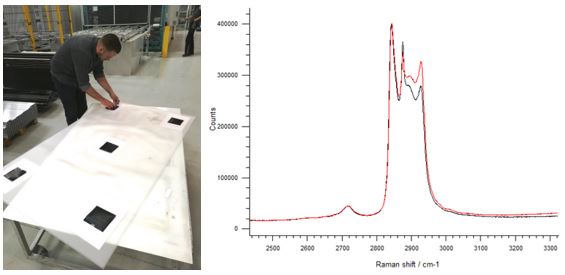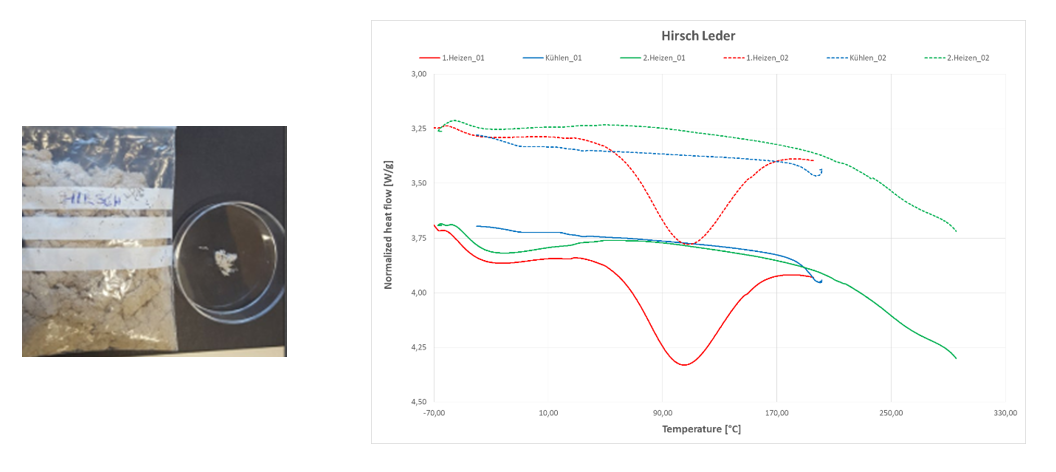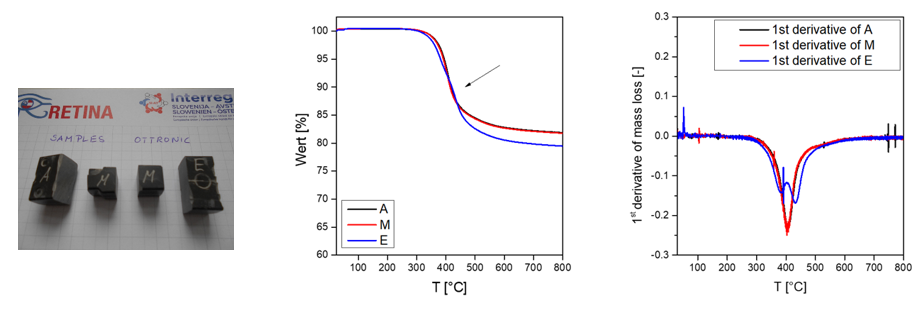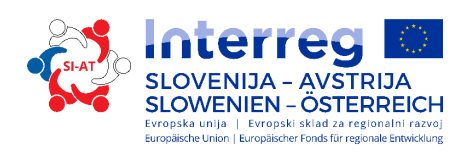Type 1 Pilot Action:
KIOTO Photovoltaics GmbH, PV-Encapsulation Material Analysis
Goal: KIOTO faces problems concerning the homogeneity of their encapsulation material after the lamination procedure of their photovoltaic modules on the secondary laminator. In order to ensure the production of reliable modules, the reason for these inhomogeneities shall be determined.
Approach: Different samples were prepared at the laminator at KIOTO. Afterwards quality of the manufactured samples was determined by identification of the degree of crosslinking of the encapsulant material. Applied methods were Raman spectroscopy, DSC and the conventionally used standard method, the Soxhlet extraction process. Additionally, spatial differences of the crosslinking factor along the samples were determined.
Results: Determination of the degree of crosslinking of the samples at different laminator positions indicated a problem at the front part of the laminator. These results were confirmed by thermal analysis measurements. A malfunctioning heating plate could be identified and replaced. Measurements afterwards showed a sufficiently high degree of crosslinking for all laminator positions.

Production of samples at KIOTO (left); Raman spectra of the encapsulant material at different positions (right)
Involved Partners: CTR/SAL, PCCL
Type 1 Pilot Action:
HIRSCH Armbänder GmbH – Analysis – Consisency of a new leather fibre combination with selected biopolymers
Goal: Constant leather quality is a prerequisite for the use of leather fibres in combination with the selected biopolymer. Fluctuations in the leather properties can lead to changes in the material compound and thus influence the production of the tape cores. A characterisation of the leather fibres is therefore indispensable.
Approach: In order to assess the quality of the leather fibres, a basic characterisation of the material is sought. The results will also serve as a reference for the future production of composites. The desired measurements/trials:
Material Information (IR), thermal stability (DSC) for the design of the processing parameters, fiber length and length distribution.
Results: Material parameter of leather fibres were measured to give information for further material decisions in the development of a new arm wristband filling material. In terms of thermal and chemical characterisation a DSC and FTIR was carried out. It was shown that the material is sufficiently thermal stable and the FTIR is comparable to the spectra of gelatine and show no major impurity. Further optical investigation were done by SAL descripted in a separate report.

DSC-measurements of the two separate leather fibres samples
Involved Partners: PCCL, CTR/SAL
Type 1 Pilot Action:
OTTRONIC Regeltechnik GmbH – Analysis – Mixing homogeneity of encapsulation material
Goal: To reinforce polymeric materials, fillers are often added. With different fillers and filler densities, uniform mixing should be ensured during the one-shot packaging process. In addition, the OH content is a decisive factor for the durability of the embedded electronics. The aim is to find out to what extent a separation took place over the flow path (during encapsulation) depending on the filler content and how high the OH content of the respective sample is.
Approach: To determine the homogeneity, the thermal stability of samples from different process sections is measured using TGA measurements and the chemical composition is measured using FTIR and an XPS measurement is performed to determine the OH groups.
Results: For the determination of the OH concentration in this material class, the XPS measurement setup turned out to be unsuitable. The IR measurements showed that all flow-dependent samples (A, M and E) are chemically identical. The mass loss curves of the TGA measurements indicate a high thermal stability of the samples and a reproducibility of sample A and M. The resin cubes A and M degrade in the same way (one degradation step), but in comparison the resin cube E has been degraded in two degradation steps, which is an indication for inhomogeneity.

TGA-measurements of filled epoxy resin samples
Involved Partners: PCCL, UNG



